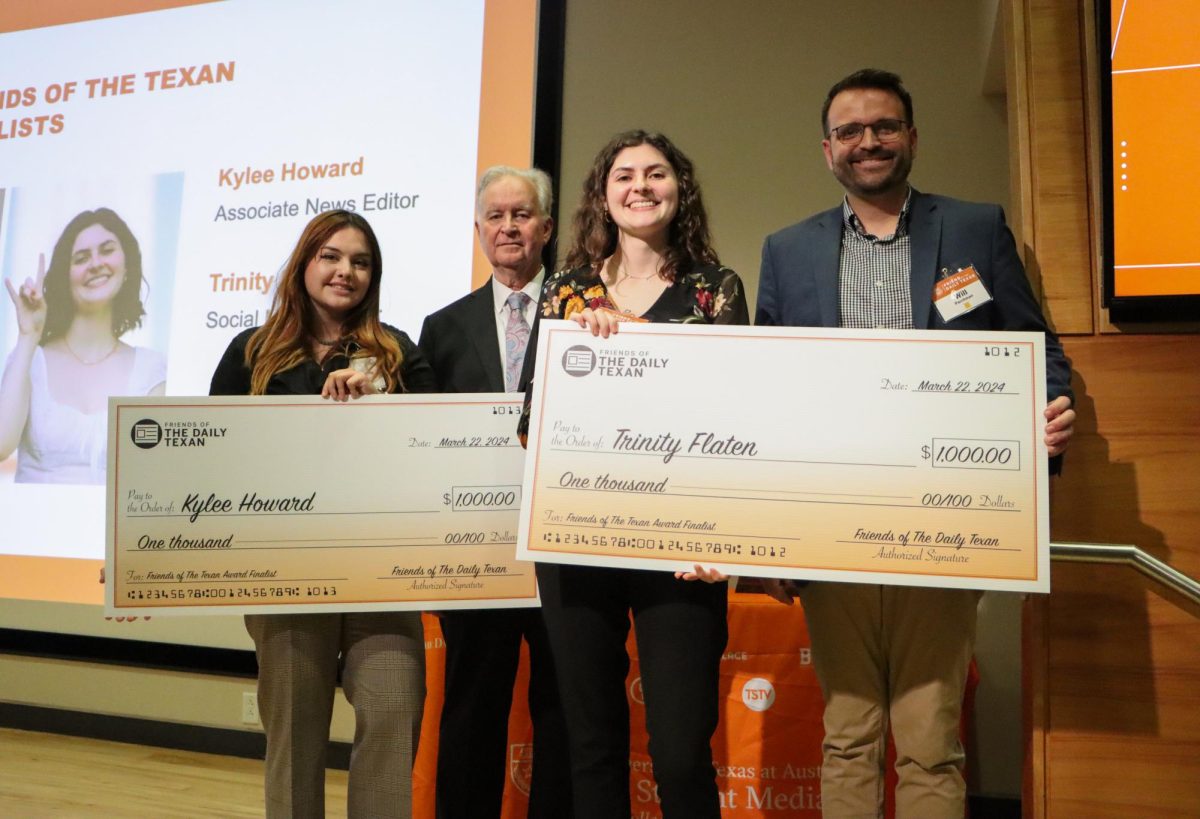Pre-Watergate-era reporter devotes life’s work to documenting ordinary detail with humanity and compassion

Gaylon Finklea Hecker served as a general assignments reporter and editor during her University of Texas career. The Daily Texan proved an ample training ground for skills like deadline diligence and fact-finding, and the newsroom atmosphere honed Hecker’s natural nose for story and emotion.
She continued on to award-winning tenures at the San Antonio Light and San Antonio Express-News, and after 35 years of interviews—along with a lot of diligence and faith—Gaylon is nearing the publication of “A Sense of Place: Famous Native Texans Remember Their Childhood,” her fifth book based on aspects of Texas history. Each first-person narrative explores the mutual blessings of those who claim Texas as their birthplace, featuring pioneering heart surgeon Denton Cooley, newsmen Bob Schieffer and Dan Rather and Texas’s revered Lady Bird Johnson.
“If what you want to do is important enough to you, don’t give up,” Gaylon says. “It got me my first job. It got me my first real published book.
“My best friend and co-author, Marianne Odom, and I have interviewed more than 33 native Texans with mostly household names—Aaron Spelling, Debbie Reynolds, Mary Kay Ash, Tommy Tune, Ray Price, Jerry LeVias, Liz Smith, Mary Martin—exclusively about their childhoods. What was it about growing up in Texas that turned them into giants, despite their often modest beginnings?
“Stay tuned to find out.”
***
 Gaylon Finklea Hecker, in her own words, on getting hired at The Texan, lessons from Griff Singer and a day at war:
Gaylon Finklea Hecker, in her own words, on getting hired at The Texan, lessons from Griff Singer and a day at war:
I know there’s a lot of competition today, I’m sure there is, to write for The Daily Texan. I don’t remember any competition. I think I just showed up one day and asked, “Do you need a writer?” I guess they did. I was general assignments for two years.
My senior year, I also laid out the editorial page, wrote a column and got to pick out the editorial cartoon, national columnist and letters to the editor. Great fun. Great training.
In my family, you had four years to get a degree. You got a degree to get married and to get a job. I didn’t get married, and I needed a job. I went to the San Antonio Light and the Corpus Christi Caller-Times. The Light wrote me back and said no thank you.
I wrote them back. Either I’m stubborn, or red-headed, or Griff [Singer] taught me persistence, but I wrote them again and said, “You made a mistake. Look at me again, because I’ll be a hard worker.” They called me in for an interview.
The secretary for the managing editor said, “You see that stack of letters on my desk there? That’s our normal stack of letters we get in the spring from new graduates like you, who want a job. You’re the only one out of the stack who wrote us back.”
The managing editor noticed and said, “Call her in here.”
That’s how I got my job.
Persistence. That’s something a journalist needs.
Our Daily Texan class, in the late 1960s and early ’70s, we were old-fashioned, down-and-dirty trained journalists. We all were taught how to research, how to write a lede. We knew how to check facts. We knew how to be fair. We all had opinions, believe me, but we didn’t have them in our news stories. We were pretty straight arrows in our reporting. Our professors saw to that.
We knew how to work hard and meet a deadline.
The coolest job in the world, to me, was to be a general assignments reporter. For someone who is easily bored, who doesn’t want to get too in depth, but can get fascinated with something for a day or two, that is the best job in the world. I’d get to work at the Light, get an assignment or two or three and had eight hours to do it. I would come back to the office and type mine up.
Day to day, I was writing my stories and rewriting others, because we all pitched in. They often put me on the rewrite desk. Remember, no computers then. If you were in the field, you had to call in your story and read it over the phone. Field reporters would tell the rewrite desk where the periods went and what letters to capitalize and when to break for a new paragraph. Some of the older reporters would just call in notes. I could fix up the copy before it ever got to the copy desk.
By the time I left the Light, its city room was filled with Daily Texan grads from my time there. Ann Bennett Robinson, Jan Jarboe, O’Lene Stone, Bruce Beal and I were reporters all at the same time. The Texan newsroom had moved to San Antonio.
When I got married, we took a yearlong honeymoon, and then after I had my daughter, I needed to go back to work. I started at the San Antonio Express-News in the women’s department. My Scene-Lifestyle department editor became the first female managing editor at the Express-News, Mildred Whiteaker. And when I get too high and mighty, I just remember Mildred telling me, “You can tell a story better than you can write one.” And that just brings you down to reality. I owe her a lot.
Persistence also got me a day at a war, which is enough in my book.
In 1982, I had relatives who lived in Israel, and the Israelis had invaded Lebanon to stop Yasser Arafat’s terrorists there. You could take expenses off your income tax if you proved you were working on trips. I always tried to work, to do something. My nephew lived across the street from Israeli government officials, and he told them I was with the San Antonio Express-News. They helped us get press credentials to get into Lebanon. We drove to Beirut, two Israeli soldiers with Uzis on their laps riding with us, and I had my day at the war. This was the best day of my life and the worst day. Because I was at the war.
 My subsequent Sunday feature story received national recognition. Among all those other reporters who went into Lebanon that day, all men, grizzled war reporters, reporting mostly the facts, I was a fresh-off-the-street woman. I wrote the color, the humanity. I talked to people working in the hospitals where the Palestinian Liberation Organization stored its missiles and bombs, and Armenian Orthodox leaders who said they felt free and safe for the first time in a long time. I tried to see different things in a war zone that jaded reporters could no longer see.
My subsequent Sunday feature story received national recognition. Among all those other reporters who went into Lebanon that day, all men, grizzled war reporters, reporting mostly the facts, I was a fresh-off-the-street woman. I wrote the color, the humanity. I talked to people working in the hospitals where the Palestinian Liberation Organization stored its missiles and bombs, and Armenian Orthodox leaders who said they felt free and safe for the first time in a long time. I tried to see different things in a war zone that jaded reporters could no longer see.
I always felt that writing for a newspaper was documenting our history. In 100 years, the stories that seem innocuous at the time leave a record for the researchers later on, when they want to know what people like us were like.
Natalie England is a writer living in Austin. By day she serves The University of Texas as a copywriter for Texas Athletics. She worked at The Daily Texan from 2001 to 2004, as a reporter, associate sports editor and finally sports editor.


